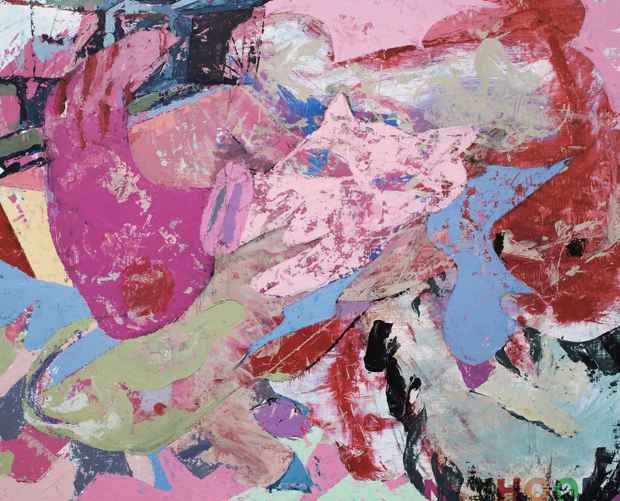Christine Burgone “Powder and Water”
Martos Gallery

[Image: Christine Burgone "Untitled" (2020) Acrylic on board 20 x 24 in.]
This event has ended.
This work revolves around modernist doubt, as Christine Burgon traces the means of creation, and how intentionality in the studio gives way to the viewer’s perception. How can one effectively locate the meaning of the work? Is it to be determined by the sensations aroused in the viewer, its operation as an “affect machine?” Or is it merely resigned to irreducibility? These are questions that Burgon absorbs. She deals with them rather than staking claim to any resolutions. Her paintings are thus points of departure, the studio operations yielding to the experience of the viewer. The artist must relinquish control post-production.
As the world drifts further away from the conditions that birthed Abstract Expressionism, the vitality of its situation persists. T.J. Clark proposes that “The ridiculous moment of coalescence, or of mourning, or of history, is what we still want from painting, and what Abstract Expressionism manages to provide.”¹ If one accepts Clark’s position, then AbEx painting’s continuation has potential. Burgon picks up on the field’s various modes. She fixates on certain coordinates and pursues a general landscape of order. In doing so, Burgon habitually turns to the early works of Eva Hesse, likewise remaining attentive to the breakdown between language and abstraction.
Todd Cronan’s Against Affective Formalism enters the frame as a substantial muse for Burgon. The writer distinguishes actual from intended effects of artworks, writing “An intended effect is one the artist sought to produce in the beholder […] An actual effect, on the other hand, is an effect that occurs in the viewer’s mind or body regardless of the artist’s intention to make that effect come off.” ² Frictions between artistic determinacy and indeterminacy fold into the attitudes of the beholder, as Cronan opines, “It is the special privilege of affects that they occur regardless of an intention,” and “matter only insofar as they occur or do not.”³ The rhythm of Burgon’s paintings errs on the disruptive, as forms are only ever suggested, never to be fully articulated. The bodies fade into abstract passages, the compositions undulating over time. She takes flight from the limitations of the body, which is often pursued until it crosses into illegibility.
Direct observation is Burgon’s initial point of departure, though she inevitably submits to a process that is always open for derailment. Thus, her compositions develop over time, often reapproached and built up by incident. She handles her paint like a sculptor navigates clay, working it out before it’s resigned to a dry state, and then pushing it a bit further. The choice of medium is calculated, as Burgon welcomes the challenges that are brought on by its plasticity. She describes its nature as obtuse, promoting acrylic newer identity in the lineage of painting. Likewise, its application requires approximation of hue and a spontaneity that must be enacted with haste.
Burgon begins with three layers of gesso to provide a smooth surface against the constraints of wood or textured canvas. She then goes in with a spontaneous layer of acrylic to slicken her base and reduce the absorptive nature of gesso. From here, issues of color and form begin to manifest. Warmth and coolness are coordinated by Burgon over time, with compositions that unfold over months and years. In the space between experience and description, a process of alienation is activated. To transfer what one sees, thinks, and feels into compositional expression is the task of an artist. This endeavor is wracked with both problems and possibilities. The oscillating forms in Burgon’s paintings extend out of this process marked by the freedom of the individual, as she stages whirlpools of miscellanea.
Her works bear no titles and thus no linguistic prescriptions, the viewer is cast into a realm of pure visual associations. In one of the larger paintings a swell of brushstrokes culminate in forms suggesting a housebound body and a distorted portrait. In this piece, tremors of Maria Lassnig’s chaotic figures (think Ich trage die Verantwortung, 1981 or Augenglaeser –Autoportraets, 1965) are operative, as they experience pain and/or ecstasy. Burgon’s body of work, however, reads as non-referential, yielding to her specific visual language. Burgon’s idiosyncrasies produce a complex matrix of perception. In each painting, one must question whether the piece exhibits a discrete network or is, perhaps, just the sum of its parts? An entangled totality arranged by lines, colors, and textures.
What persists throughout the show is a stable sense of direction. Burgon’s relationships to drawing - often regarded as a provincial concern - and painting - deemed authoritative in the canon of art-making - collapse in the gallery as the two mediums are placed in direct conversation. One can appreciate the leavening of territories, as drawing and painting are viewable at once. Works on paper can be read like fieldnotes, each mark intrinsically linked to the artist’s conception of form.
In an interview for BOMB, Cronan posits that “The perfect work of art, the autonomous one, passes through the logic of identity (more broadly, the logic of what Poe calls ‘the affairs of the world’) and by doing so points beyond itself to the kinds of structures that make exploitation possible (which is not a matter of identities) and to maybe the promise of something better than the way we live now, or at least a world with vastly more time to engage and make art than we currently have.”⁴ Burgon’s colorful, gestural abstractions dutifully take the history of authority and machismo to task.
¹ Clark, T.J. “In Defense of Abstract Expressionism.” October, vol. 69, summer 1994, pp. 22–48, https://doi.org/10.2307/778988.
² Cronan, Todd. Against Affective Formalism: Matisse, Bergson, Modernism. University of Minnesota Press, 2013.
³ ibid
⁴ Gilbert-Rolfe, Jeremy, and Todd Cronan. “Todd Cronan by Jeremy Gilbert-Rolfe.” BOMB Magazine, 5 May 2015.
Media
Schedule
from May 18, 2023 to June 24, 2023